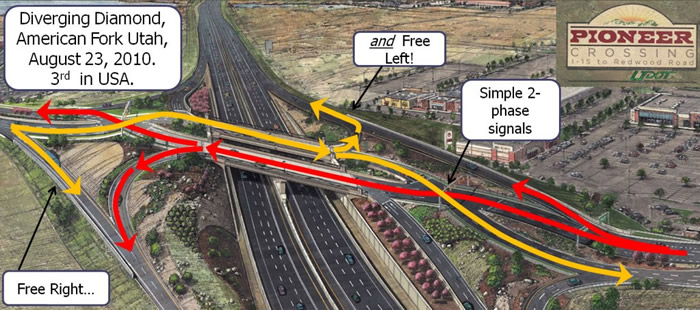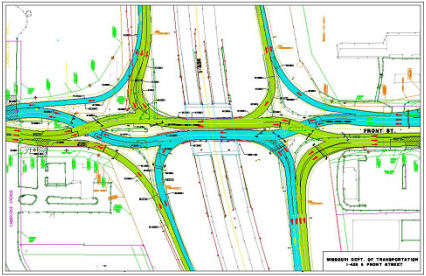
An award-winning innovation
|
|
|||||||||||||||
|
We are associated with many of the world's leading experts in intersection efficiency and sustainable design.
Innovative Sponsors
Sponsored Links
How To ...
|
Diverging Diamonds - High Efficiency at a Modest Price!The DDI - an Award Winning Innovation!  Diagram of Movements in a Diverging Diamond Interchange
Diagram of Movements in a Diverging Diamond InterchangeWhy are interchange areas always so congested?
Freeway interchanges can be a nightmare. Even if you're not
planning to get on the freeway, simply crossing it can take forever at
peak periods. Part of the cause is that signals at each ramp on a
traditional Diamond Interchange must have left-turn arrows, which
introduces inefficiency.
SPUIs improved efficiency! ...at a price.
The now popular Single-Point Urban Interchange, or SPUI, was a
big operational improvement over the Diamond because it uses just one
signal in the center, rather than two for each ramp. But the SPUI itself
uses a four-phase signal with left-turn arrows, where the most
efficient signals have just two phases. And because the signal must be
in the center, ramps must approach the center diagonally, which requires
larger bridge decks and wider spans - greatly increasing the cost of a
SPUI relative to a Diamond.
|
|
||||||||
 Flows that are part of the Eastbound stream, vs. those that are part of the Westbound stream
Flows that are part of the Eastbound stream, vs. those that are part of the Westbound stream
DDI's: Safe, Efficient, Low Cost!The Diverging Diamond is based on the idea that if you can
eliminate the need for left-turn arrows, then signals will have maximum
efficiency, fewer conflict points, and be able to serve more traffic
with better safety and less congestion.
|
||||||||||